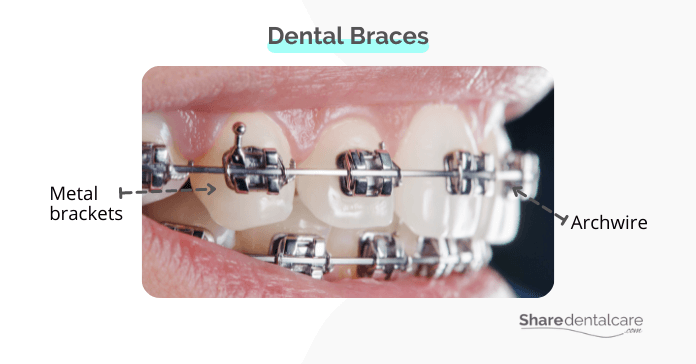Do you have teeth crowding? If so, you are not alone. In fact, teeth crowding is one of the most common dental problems. Crowding occurs when there is not enough space in the mouth for all of the teeth to fit comfortably. This can cause problems with biting and chewing and can also lead to tooth decay and gum disease. In this blog post, we will discuss the causes of minor crowding of teeth and some of the treatments available to correct the problem.
What Does Minor Teeth Crowding Mean?
Teeth crowding is a type of dental malocclusion in which the teeth overlap or crowd each other in the mouth. The severity of teeth crowding can be minor (mild), moderate, or severe.
- Minor crowding (mild): The crowded tooth or teeth are 1mm to 3mm from their correct position.
- Moderate crowding: The crowded tooth or teeth are 4mm to 6mm from their correct position. You can read more about moderate teeth crowding.
- Severe crowding: The crowded tooth or teeth are more than 7mm from their correct position. You can read more about severe teeth overcrowding.

Causes of Minor Teeth Crowding
One of the most common causes is genetic factors. If your parents or grandparents had crowded teeth, you’re more likely to have crowded teeth as well. Other causes of minor teeth crowding include:
- The early loss of baby teeth: If baby teeth are lost too early, the permanent teeth may come in too close together.
- Over-retained baby teeth: If baby teeth are not lost on schedule, they can crowd the permanent teeth that are trying to come in.
- Jaw size: small jaws can lead to crowded teeth.
- Large teeth: teeth that are larger than average can also cause crowding.
- Misaligned jaws: If the upper and lower jaws are not aligned properly, it can cause teeth crowding.
- Trauma: An injury to the face can cause teeth crowding.
Read more about whether crowded baby teeth can affect permanent teeth.
Treatment Options for Minor Crowding of Teeth
While minor crowding of teeth may not require treatment, some people may choose to correct the problem for aesthetic reasons. If you are unhappy with the way your teeth look, there are a few treatment options available.
Traditional Braces
Braces are the most common orthodontic treatment for teeth crowding. They work by gradually moving the teeth into their proper position. The treatment time can vary depending on the severity of your crowding, but it is usually between 12 and 24 months.
Braces are metal brackets glued to the teeth and connected with a wire. The wire is tightened periodically to move the teeth. You will need to see your orthodontist every month to have the wire tightened. Dental braces can be used for mild, moderate, and severe teeth crowding.
Braces are difficult to clean around, so you will need to take extra care of your teeth and gums. Also, they can be uncomfortable at first, and you may have to adjust your diet to avoid foods that can damage the braces. Many people don’t like the metallic look of braces, which can be a downside. Ceramic braces can offer a more aesthetic look, but they are usually more expensive than metal braces.

Clear Aligners
Clear aligners, such as Invisalign, are another popular orthodontic treatment that can be used to treat minor teeth crowding. Invisalign consists of clear, plastic aligners that are custom-made for your teeth. The aligners are worn for 20 to 22 hours a day and are changed every two weeks. Treatment time is usually between 12 and 18 months.
Clear aligners are less visible than braces and can be removed for eating, brushing, and flossing. But, they require a high level of compliance from the patient to be effective. Clear aligners can be used for minor and moderate teeth crowding. However, they are not recommended for severe crowding. You can read more about Invisalign for severely crowded teeth.

Dental Veneers
Dental veneers are a cosmetic dental treatment that can be used to improve the appearance of chipped, broken, or discolored teeth. Also, they can be used to treat minor teeth crowding. Veneers are thin, tooth-colored shells that are bonded to the front surface of the teeth. They are made out of porcelain or resin-composite materials.
Dental veneers are a quick and easy way to improve the appearance of your teeth. The treatment can be done in one or two visits to the dentist. However, veneers don’t change the position of your teeth but only make the crowded teeth appear straight. Besides, veneers require the removal of a thin layer of tooth enamel, which is irreversible. You can read more about veneers for overlapping teeth.
Minor Teeth Crowding – Conclusion
Minor crowding of teeth is a common problem that is usually caused by genetic factors. While minor crowding may not require treatment, some people may choose to correct the problem for aesthetic reasons. The most common treatments for minor teeth crowding are braces and clear aligners. Dental veneers are also an option for people who want a quick and easy way to improve the appearance of their teeth.
If you have minor crowding of teeth and are considering treatment, be sure to talk to your orthodontist or dentist to find out which option is best for you.